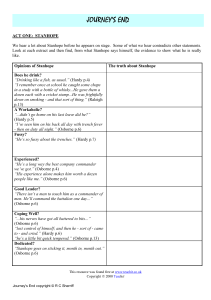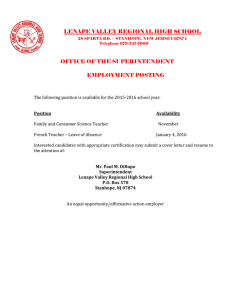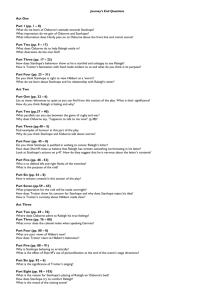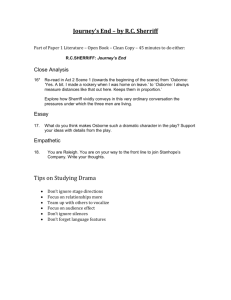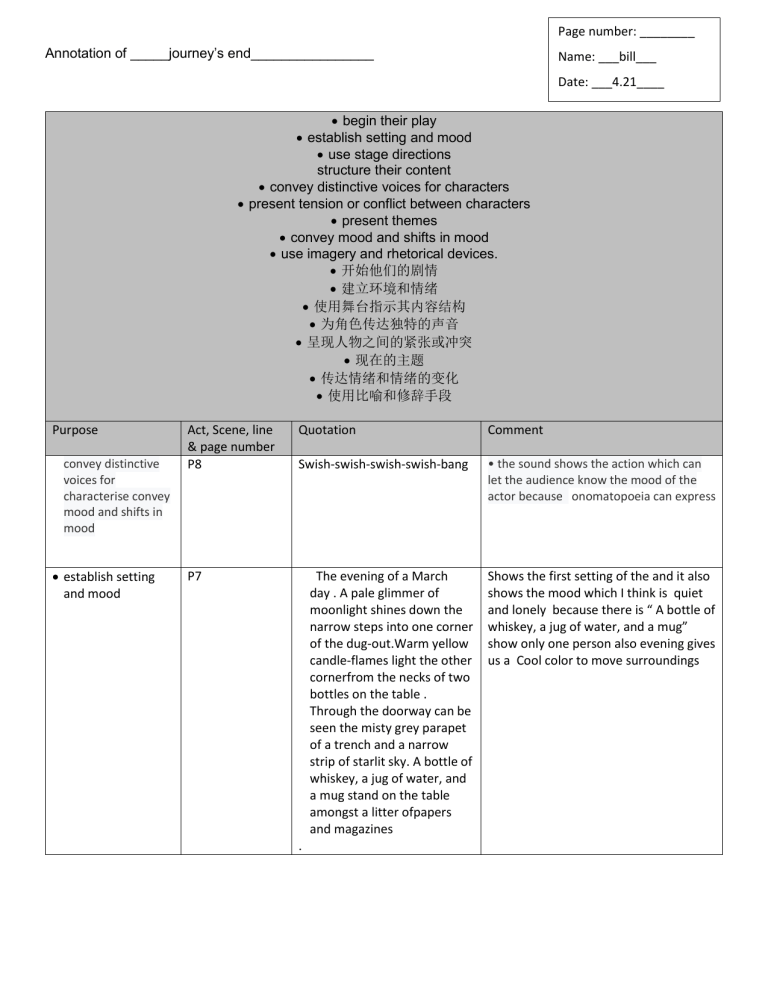
Page number: ________
Annotation of _____journey’s end________________
Name: ___bill___
Date: ___4.21____
begin their play
establish setting and mood
use stage directions
structure their content
convey distinctive voices for characters
present tension or conflict between characters
present themes
convey mood and shifts in mood
use imagery and rhetorical devices.
开始他们的剧情
建立环境和情绪
使用舞台指示其内容结构
为角色传达独特的声音
呈现人物之间的紧张或冲突
现在的主题
传达情绪和情绪的变化
使用比喻和修辞手段
Purpose
convey distinctive
voices for
characterise convey
mood and shifts in
mood
establish setting
and mood
Act, Scene, line
& page number
P8
Quotation
Comment
Swish-swish-swish-swish-bang
• the sound shows the action which can
let the audience know the mood of the
actor because onomatopoeia can express
P7
The evening of a March
day . A pale glimmer of
moonlight shines down the
narrow steps into one corner
of the dug-out.Warm yellow
candle-flames light the other
cornerfrom the necks of two
bottles on the table .
Through the doorway can be
seen the misty grey parapet
of a trench and a narrow
strip of starlit sky. A bottle of
whiskey, a jug of water, and
a mug stand on the table
amongst a litter ofpapers
and magazines
.
Shows the first setting of the and it also
shows the mood which I think is quiet
and lonely because there is “ A bottle of
whiskey, a jug of water, and a mug”
show only one person also evening gives
us a Cool color to move surroundings
• convey distinctive
voices for characters
• convey mood and
shifts in mood
P8
Hullo, Osborne ! Your fellows
arriving?
I’d rather have the microbes,
wouldn’t you ?
The words that Hardy said shows that
he is excited (mood)and also we know
that he love to tell jokes
• use imagery and
rhetorical devices.
P9
Hardy : I should say—
roughly—about two million ;
but then, of course, I don’t see
them all.
By exaggerate the amount of rats to
show that Hardy is a humor and kindly
man because he use the rats ”joke” to
remind other to take care of shoes and
cloth
convey distinctive
voices for
characters
use imagery and
rhetorical devices.
P11
By using “damn it ”to show he is kind of
unconstrained which let the readers
know that he is a real soldier the
imagery have the function of change
the mood and change to the next topic
convey distinctive
voices for
characters
use imagery and
rhetorical devices.
P12
use imagery and
rhetorical devices.
P12
Well, damn it, it’s just the
natural thing to ask about
Stanhope. (He pauses, and
looks curiously at Osborne.)
Poor old man. It must be
pretty rotten for you, being his
second in command, and you
such a quiet, sober old
thing.
Hardy : Well, damn it, it’s
pretty dull without something
to liven people up. I mean,
after all
Stanhope really is a sort of
freak ; I mean it is jolly
fascinating to see a fellow
drink like he does—glass after
glass. He didn’t go home on his
last leave, did he ?
Osborne : When a boy like
Stanhope gets a reputation out
here for drinking, he turns into
a kind of freak show exhibit.
People pay with a bottle of
whiskey for the morbid
curiosity of seeing him drink it.
begin their play
P13
Osborne : Don’t be an ass. He
was out here before I joined
up. His experience alone
makes him worth a dozen
people like me.
Hardy : You know as well as I
do, you ought to be in
command.
From talking and make joke to Stanhope
to disagree that Stanhope can not be
the leader may start a new plot event
By using “damn it ”to show he is kind of
unconstrained which let the readers
know that he is a typical soldier the
imagery have the function of improve
Hardy’s characteristic because his
imagery is always kind of likes “rude”
Using imagery to show that how crazy
will Stanhope be when he is drunk
use imagery and
rhetorical devices.
P14
convey distinctive
voices for
characters
P14
use imagery and
rhetorical devices.
Hardy : God ! you are a
worker. Oh, well. Here we are.
(He finds a tattered little hook
among the papers on the
table.) Written right up to
date ; here’s my last entry : “ 5
p.m. to 8 p.m. All quiet.
German airman flew over
trenches. Shot a rat.”
Hardy : No. I shot the rat, you
ass. Well, finish up your
whiskey. I want to pack my
mug. I’ll leave you that drop in
the bottle.
Use a imagery to complain show how
bored it is and the feeling to face the
german
P15
Hardy (fully dressed) : There
we are ! Do I look every inch a
soldier ?
Use imagery to show that Hardy is
prepared for war and he is also excited
to fight with german
use imagery and
rhetorical devices.
P16
Mason : Yes, sir. Ordinary
ration meat, but a noo shape,
sir. Smells like liver, sir, but
it ’asn’t got that smooth, wet
look that liver’s got.
Use the imagery to show the how
nausea of this meat is although it is rare
begin their play
use stage
directions
use imagery and
rhetorical devices.
P17
There is a pause,then the gruff
voice says:
“Better go down, sir.” The
boyish voice replies : 44 Yes.
Righto.” An Officer comes
groping down the steps and
stands in the candle-light. He
looks round, a little
bewildered. He is a well-built,
healthy-looking boy of about
eighteen, with the very new
uniform of a 2nd
lieutenant.
First the voice shows than use imagery
to describe the new character also
shows his patient and the pause is the
direction
To show the straight and “rude ”that
hardy is .
establish setting
and mood
P18
use stage
directions
structure their
content
P18
establish setting
and mood
P19-20
use imagery and
rhetorical devices.
use imagery and
rhetorical devices.
Osborne : —and the water
takes away the taste of the
whiskey. (He hands Raleigh the
drink.) Just out from England ?
Raleigh : Yes, I landed a week
ago.
Osborne : Boulogne ? Raleigh :
Yes. (A pause, then he selfconsciously holds up his drink.)
Well, here’s luck, sir.
Osborne (taking a drink
himself) : Good luck. (He takes
out a cigarette case.)
Cigarette ?
Raleigh : Thanks.
Osborne (holding a bottle
across so that Raleigh can light
his cigarette from the candle in
it) : Ever been up in the line
before ? Raleigh : Oh, no. You
see, I only left school at the
end of last summer term.
Osborne : I expect you find it a
bit strange. Raleigh (laughing) :
Yes—I do—a bit
Raleigh : Yes, rather ! We were
at school together—at least—
of course—I was only a kid and
he was one of the big fellows ;
he’s three years older than I
am.
……………Raleigh : No. From my
sister. Osborne : Your sister ?
The questions shows the
background(some information) about
Raleigh like he is just arrive and the
mood is like normal
P21
Raleigh {laughing) : Oh, I know
old Dennis’s temper ! I
remember once at school he
caught some di^aps in a study
with a bottle of whiskey. Lord !
the roof nearly blew off. He
gave them a dozen each with a
cricket stump.
So it use exaggeration to show that how
bad and rude is Stanhope .
P23
Osborne : Those are the guns
up north—up Wipers way. The
guns are always going up
there ; it’s never quiet like this.
Use the imagery to show how cruel is
the war at the top of the region every
where is ruin
use stage directions structure
Raleigh’s characteristic is pilite and
kind just like a positive boy
By Raleigh’s story we know some new
background of both the character
Raleigh and Stanhope
use imagery and
rhetorical devices.
P24
Raleigh : By trench. An
amazing trench
—turning and twisting for miles,
over a sort of
plain.
Use personification to shows that the
trench’s twisting and long
begin their play
use stage
directions
structure their
content
P26
Kind of new character is appear to start
a new plot event and from his
appearance shows out his propoties
establish setting
and mood
use stage
directions
structure their
content
convey distinctive
voices for
characters
present tension
or conflict
between
characters
present themes
P26
use stage
directions
structure their
content
convey distinctive
voices for
characters
P30
[The voices grow nearer ; two
figures appear in the trench
above and grope down the
steps—the leading figure tall
and thin, the other short
andfat. The tall figure is
Captain Stanhope. ……..
apparently he has put on
weight during his war
service
, for his tunic appears to be on
the verge of bursting at the
waist. He carries an extra pack
belonging to the officer left on
duty in the line.
Osborne : Yes. He cleared off a
few minutes ago.
Stanhope : Lucky for him he
did. I had a few words to say to
Master Hardy. You never saw
the blasted mess those fellows
left the trenches in. Dug-outs
smell like cess-pits ; rusty
bombs ; damp rifle grenades ;
it’s perfectly foul. Where are
the servants ?
Osborne : In there.
Stanhope (<calling into
Mason’s dug-out) : Hi !
Mason !
Mason (outside) : Coming, sir !
Just bringing the soup, sir.
Stanhope (taking a cigarette
from his case and lighting it) :
Damn the soup ! Bring some
whiskey !
Trotter : Well, boys ! ’Ere we
are for six days again. Six
bloomin’ eternal days. {He
makes a calculation on the
table.) That’s a hundred and
forty-four hours ; eight
thousand six ’undred and forty
minutes. That doesn’t sound
so bad ; we’ve done twenty
So it show the characteristic of the
Stanhope and the bad temper he got is
straight going to start a conflict
Use stage direction to show how patient
trotter shows the characteristic of
trotter
of ’em already. I’ve got an
idea ! I’m going to draw a
hundred and fortyfour little
circles on a bit o’ paper, and
every hour I’m going to black
one in ; that’ll make the time
go all right.
use stage
directions
structure their
content
convey mood and
shifts in mood
P35
convey distinctive
voices for
characters
P36
use imagery and
rhetorical devices
P40
Osborne (filling his pipe) : I
wonder if he really is bad. He
looks rotten.
Stanhope : Pure bloody funk,
that’s all. He could eat if he
wanted to ; he’s starving
himself purposely. Artful little
swine ! Neuralgia’s a splendid
idea. No proof, as far as I can
see.
Stanhope {looking up quickly
at Osborne and
laughing
)
: Yes, I’m his hero.
Osborne : It’s quite natural.
Stanhope : You think so ?
Osborne : Small boys at school
generally have their heroes.
Stanhope : Yes. Small boys at
school do.
Osborne : Often it goes on as
long as Stanhope : —as long as
the hero’s a hero.
Osborne : It often goes on all
through life.
Stanhope : It’s no good, Uncle.
Didn’t you see him sitting
there at supper ?—staring at
me ?
—
and wondering ? He’s up in
those trenches now —still
wondering—and beginning to
understand. And all these
months he’s wanted to be with
me out here. Poor little devil !
The action which Stanhope shows are
having much more different than they
think so they change from dislike to all
right
Shows that Stanhope’s confident and it
a kind of turning point because they
start to talk to each other with no that
kind of “level” different seems that the
conflict have been weaken
It just shows the time and some normal
information from the outside of these
sentence but it shows the cruel of the
war that separate person and person for
month it also shows the relationship the
friendsip between them
establish setting
and mood
convey mood and
shifts in mood
P43
Stanhope stirs, and mutters in
his sleep. In the quiet can be
heard the low rumble of the
guns up north .
Use setting to show the atmosphere it a
good way to end a plot
use imagery and
rhetorical
devices.
P45
Thin ! Thin wasn’t the word.
Put a bucketful of ’is stew in a
bath and pull the plug, and the
whole lot would go down in a
couple of
gurgles.
Use exaggeration to show the bad
condition
convey mood and
shifts in mood
P52
The chat shows the fun and good
relationship between the main
character
•use imagery and
rhetorical devices.
P57
But, when our men began
dragging the wounded man
back over the rough ground, a
big German officer stood up in
their trenches and called out :
C£ Carry him ! ”—and our
fellows stood up and carried
the man back, and the German
officer fired some lights for
them to see by. Raleigh : How
topping ! Osborne : Next day
we blew each other’s trenches
to blazes.
Stanhope : I hope so. I
wondered if there was
anything wrong with me.
D’you ever get a sudden
feeling that everything’s going
farther and farther away—till
you’re the only thing in the
world—and then the world
begins going away—until
you’re the only thing m—in the
universe—and you struggle to
get back—and can’t ?
Stanhope : You think so ?
( There is a pause.) I heard you
go on duty last night. After
you’d gone, I got up. I was
feeling bad. I forgot Raleigh
was out there with Trotter. I’d
forgotten all abouthim. I was
sleepy. I just knew something
beastly had happened. Then
he came in with Trotter—and
looked at me. After coming in
•convey mood and
shifts in mood
present tension
or conflict
between
characters
P59
Use imagery to show the hopeless of
these men
The action of wakeup at night show that
present tension
or conflict
between
characters
P72
present themes
convey mood and
shifts in mood
P72
present themes
convey mood and
shifts in mood
P73
out of the night air, this place
must have reeked of candlegrease, and rats—and whiskey.
One thing a boy like that can’t
stand is a smell that isn’t fresh.
He looked at me as if I’d hit
him between the eyes—as if
I’d spat on him Osborne : You
imagine things. Stanhope
(1laughing) : Imagine things !
No need to imagine !
Osborne : Why can’t you treat
him like any other youngster ?
[ There is silence ; a few
seconds go by. Suddenly
Hibbert bursts into a highpitched laugh .
……..gives a little cry . He opens
his eyes and stares vacantly
into Stanhope’s face. Stanhope
is smiling. Stanhope : Good
man, Hibbert. I liked the way
you stuck that. Hibbert
(hoarsely) : Why didn’t you
shoot ? Stanhope : Stay here,
old chap—and see it through
Hibbert : Stanhope ! I’ve tried
like hell—
I
……..I’ll never go up those
steps again—into the line—
with the men looking at me—
and knowing—I’d rather die
here. {He is sitting on
Stanhope’s bed, crying without
effort to restrain
himself)
Stanhopf : Because I feel the
same—exactly the same !
Every little noise up there
……loathe it all. Sometimes I
feel I could just lie down on
this bed and pretend I was
paralysed or something—and
couldn’t move—and just lie
there till I died—or was
dragged away.
The dialogue shows the tension
between Stanhope and the Hibbert also
present the mood of everyone.
Use soliloquy to show the mood like
“the raven ”fill with hopeless and the
death and nevermore!
Use soliloquy to show the mood like
“the raven ”fill with hopeless and the
death and nevermore!
convey mood and
shifts in mood
P74
present tension
or conflict
between
characters
present themes
convey mood and
shifts in mood
P111
•
establish
setting and mood
P126-P127
: If you went—and left
Osborne and Trotter and
Raleigh and all those men up
there to do your work—could
you ever look a man straight in
the face again—in all your
life ?
……..{Again there is silence.)
Stand in, old chap—and do
your share.
Stanhope : Now, look here. I
know you’re new to this, but I
thought you’d have the
common sense to leave the
men alone to their meals. Do
you think they want an officer
prowling round eating their
rations, and sucking up to
them like that ? My officers are
here to be respected—not
laughed at.
[Stanhope goes to the lefthand dug-out, and Raleigh is
alone, very still and quiet, on
Osborne’s bed. The faint rosy
……moan. Stanhope comes
back with a blanket. He takes a
candle from the table and
carries it to Raleigh’s bed. He
puts it on the box beside
Raleigh and speaks cheerfully.
The mood from conflict to calm down
now Stanhope start to persuade the
conflict or you can say this plot is
coming to an end
This paragraph shows the conflict
between both man started
The imagery of the sky show this
moment would not be normal which
start to give us a sign for Raleigh is going
to died
